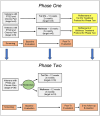Protocol for remote Tai Chi and wellness for PTSD and pain in veterans
- PMID: 39466656
- PMCID: PMC11520095
- DOI: 10.1080/20008066.2024.2411140
Protocol for remote Tai Chi and wellness for PTSD and pain in veterans
Abstract
Background: Posttraumatic stress disorder (PTSD) is a debilitating psychological disorder that is associated with a host of psychosocial and health ailments, including chronic pain. Although evidence-based psychological therapies are recommended as first-line PTSD treatments, a large proportion of individuals either drop out and/or do not achieve a therapeutic response. PTSD is increasingly recognized as a systemic disorder that impacts both physical and mental health, and mind-body approaches, such as Tai Chi, have shown promise. However, to date there have been no randomized clinical trials examining Tai Chi as a treatment for PTSD.Objective: To conduct a fully remote two-phased study designed to adapt, refine, and standardize two group treatments, Tai Chi and a Wellness comparison, for Veterans diagnosed with PTSD and chronic pain.Method: We deploy the project in two phases. In Phase One, we adapt both interventions for delivery via a videoconferencing platform. We then pilot the interventions in a 'dry run' with non-random assignment of 12 participants to Tai Chi or a Wellness comparison group. In Phase Two, we randomize 36 participants to one of the two group interventions. The feasibility and acceptability of the two remotely delivered interventions and assessment protocols are evaluated.Conclusions: This is the first study to our knowledge to evaluate the feasibility, acceptability, adherence, and participant burden of the Tai Chi and Wellness comparison interventions for PTSD and chronic pain in Veterans. This information will facilitate the development of a future large, randomized control trial to evaluate the efficacy of Tai Chi to address PTSD and chronic pain in Veterans.
Antecedentes: El trastorno de estrés postraumático (TEPT) es un trastorno psicológico debilitante que se asocia con una serie de dolencias psicosociales y de salud, incluido el dolor crónico. Aunque se recomiendan terapias psicológicas basadas en evidencia como tratamientos de primera línea para el TEPT, una gran proporción de personas abandonan el tratamiento o no logran una respuesta terapéutica. El TEPT se reconoce cada vez más como un trastorno sistémico que afecta tanto la salud física como la mental, y los enfoques mente-cuerpo, como el Tai Chi, han demostrado ser prometedores. Sin embargo, hasta la fecha no se han realizado ensayos clínicos aleatorizados que examinen el Tai Chi como tratamiento para el TEPT.
Objetivo: Realizar un estudio de dos fases completamente remoto diseñado para adaptar, refinar y estandarizar dos tratamientos grupales, una comparación entre el grupo de Tai Chi y el de bienestar, para veteranos diagnosticados con TEPT y dolor crónico.
Método: Implementamos el proyecto en dos fases. En la Fase Uno, adaptamos ambas intervenciones para su entrega a través de una plataforma de videoconferencia. Luego, probamos las intervenciones en un ensayo piloto con una asignación no aleatoria de 12 participantes a un grupo de comparación de Tai Chi o Bienestar. En la Fase Dos, asignamos aleatoriamente a 36 participantes a una de las dos intervenciones grupales. Se evalúa la viabilidad y aceptabilidad de las dos intervenciones y protocolos de evaluación a distancia.
Conclusiones: Este es el primer estudio que conocemos que evalúa la viabilidad, aceptabilidad, adherencia y carga para los participantes de las intervenciones de comparación de Tai Chi y Bienestar para el TEPT y el dolor crónico en veteranos. Esta información facilitará el desarrollo de un futuro ensayo controlado aleatorizado a gran escala para evaluar la eficacia del Tai Chi para abordar el TEPT y el dolor crónico en veteranos.
Keywords: PTSD; TEPT; Tai Chi; Veteranos; Veterans; bienestar; chronic pain; dolor crónico; ensayo controlado aleatorizado; randomized controlled trial; wellness.
Plain language summary
Despite the increasing interest in and use of mind–body practices for PTSD, there have been no randomized clinical trials to date examining Tai Chi as a treatment for PTSD.In the current study, we refine two interventions that are then used to conduct a small, randomized trial that evaluates feasibility, acceptability, adherence, and participant burden of Tai Chi and a Wellness comparison intervention in Veterans.Results of this study are expected to provide critical information to inform a future large-scale randomized efficacy trial of Tai Chi for PTSD and chronic pain.
Conflict of interest statement
Acknowledgements
The content is solely the responsibility of the authors and does not necessarily represent the official views of the National Institutes of Health, the U.S. Department of Veterans Affairs, or the United States Government.
Figures
References
Publication types
MeSH terms
Grants and funding
LinkOut - more resources
Full Text Sources
Medical

